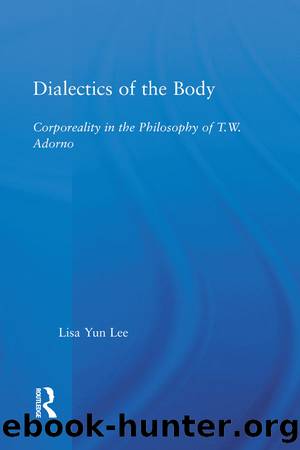Dialectics of the Body by Lee Lisa Yun;

Author:Lee, Lisa Yun;
Language: eng
Format: epub
ISBN: 4523667
Publisher: Taylor and Francis
Benjamin, deeply entrenched in psychoanalysis, places gesture within a Freudian discourse, locating the spontaneous in the realm of the unconscious and the pre-linguistic. For Benjamin, gesture becomes the “material and matrix of the language of the unconscious.”56
Adorno also draws a connection to Freud, describing Kafka’s writing as an experiment that attempts to see what would happen “if the results of psychoanalysis were to prove true not merely metaphorically but in the flesh.”57 As I discussed in Chapter 1, Adorno’s frustration with Freud is due to Freud’s own tendency to treat his own work metaphorically and not take his own observations to their deliberate and logical conclusions. According to Adorno, Freud ignores the physical reality of the mind and the body that his own theory suggests. Adorno praises Kafka for “taking psychoanalysis more exactly at its word than it does itself.”58 Gestures, for Adorno, are not merely expressions of unconscious desires, but expressions of material reality that do not indicate the need for therapy, but point instead to oppressive social contradictions. These expressions “do not stop at the subject as psychology, but drive through to the bare material existence that emerges in the subjective sphere through the total collapse of a submissive consciousness, divest of all self-assertion”59
Benjamin chooses to compare Kafka’s use of gesture to the Chinese theatre. It is worth noting that Bertolt Brecht also developed a theory of gesture—or what he called gestus or geste—during this same period.60 Benjamin admires the ability of the Chinese to “dissolve happenings into their gestic components,” which “alienates the reader” and causes them to “distance themselves from the event.”61 Adorno, however, purposefully dissociates himself from this understanding of gesture and chooses to situate his discussion in a different context. Writing in 1934 to Benjamin, he described Kafka’s novels as “the last, vanishing textual links to silent film (which not coincidently disappeared almost at the time of Kafka’s death); the ambiguity of gesture lies somewhere between sinking into speechless-ness (the deconstruction of language) and the emergence of the latter in music …”62 Adorno compares Kafka’s use of gesture to silent film, which became obsolete with the advent of new technological development. Adorno’s choice to positively compare Kafka’s works to silent film is a surprising twist to the conventional understanding of the difference between Benjamin and Adorno on film, which maintains that while Benjamin traces the parallels between the film medium’s artistic and economic modes of production of consumption, Adorno pursues tensions within the work of art that give expression to tensions in society as a whole. Therefore, when Benjamin looked at the mass-produced and mass consumed films, he saw revolutionary potential. Adorno, on the other hand, could only see how Hollywood cinema dissolves and glosses over tensions to produce a “happy end” that lulls the masses into complacency. Recently, however, there have been several attempts to revisit Adorno’s ideas about the medium of film, and to suggest a more complex reading of his understanding of film technology, mass media and products of the culture industry.
Download
This site does not store any files on its server. We only index and link to content provided by other sites. Please contact the content providers to delete copyright contents if any and email us, we'll remove relevant links or contents immediately.
The remains of the day by Kazuo Ishiguro(7582)
Tools of Titans by Timothy Ferriss(6972)
The Black Swan by Nassim Nicholas Taleb(6209)
Inner Engineering: A Yogi's Guide to Joy by Sadhguru(5917)
Giovanni's Room by James Baldwin(5898)
The Way of Zen by Alan W. Watts(5813)
The Six Wives Of Henry VIII (WOMEN IN HISTORY) by Fraser Antonia(4801)
The Power of Now: A Guide to Spiritual Enlightenment by Eckhart Tolle(4777)
Astrophysics for People in a Hurry by Neil DeGrasse Tyson(4631)
Asking the Right Questions: A Guide to Critical Thinking by M. Neil Browne & Stuart M. Keeley(4606)
12 Rules for Life by Jordan B. Peterson(3755)
The Ethical Slut by Janet W. Hardy(3517)
Skin in the Game by Nassim Nicholas Taleb(3486)
Housekeeping by Marilynne Robinson(3424)
The Art of Happiness by The Dalai Lama(3394)
Double Down (Diary of a Wimpy Kid Book 11) by Jeff Kinney(3289)
Skin in the Game: Hidden Asymmetries in Daily Life by Nassim Nicholas Taleb(3276)
Walking by Henry David Thoreau(3240)
12 Rules for Life: An Antidote to Chaos by Jordan B. Peterson(3211)
